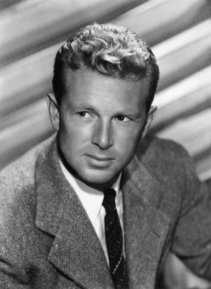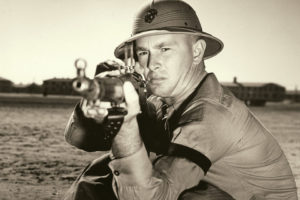
You might remember this man in the role of the somewhat psychotic Air Force General Ripper in the 1964 film, Dr. Strangelove—or as the brutally corrupt police chief in the 1972 film The Godfather, but by the time these two films became box-office successes, Sterling Hayden had already starred in films for twenty-three years. He stood 6’5” tall and weighed around 230 pounds. In some Hollywood circles, he was ‘the most beautiful man in movies.’ But, as it turns out, Sterling Hayden was much more than that.
He was christened Sterling Relyea Walter shortly after his birth in Montclair, New Jersey on 26 March 1916. After the death of his father, he went to live with his maternal uncle, whose name he took. Like many young men of his day, he yearned for the adventurous life, so at the age of 16-years, Hayden quit school and joined the crew of a sailing schooner out of New London, Connecticut. Over the next nine years, the cocky teenager followed the sea and the wind. He began his sea adventure as a common seaman; by 1940, he’d earned his master’s license. It was his love for the sea that brought him into contact with fellow sailing enthusiast David Rumsey Donovan, the son of William J. Donovan [1].
Hayden’s good looks and his cocky attitude earned him a Hollywood screen test in 1938 with Jeanne Cagney, the sister of actor James Cagney. Placed on the studio payroll at $250.00/week, his first two movies (both released in 1941) brought him instant fame throughout the country. Life was good. He was earning a good income in those days, and he was engaged to the beautiful starlet Madeleine Carroll. Despite his success, something was missing. In late 1941, Hayden received a cryptic message from “Wild Bill” Donovan, who wondered if Hayden had what it takes to complete British Commando School.
Hayden sailed to Scotland in November 1941, successfully completing the commando course in February 1942. He was later assigned to parachute training and had ten jumps to his credit when he received serious injuries during a night training exercise. Landing in a rock quarry, Hayden suffered a broken ankle, dislocated knee, and spinal injuries. He was returned to the United States and he married Miss Carroll [2]. Hayden was moody throughout his recovery; he wasn’t happy being placed on the sidelines. David Donovan urged him to apply for a commission in the US Navy, but as it turned out, the Navy wasn’t looking for sailing masters with bad legs and injured spines. After being turned down for the Navy, Hayden sailed his schooner to the West Indies.
While in Curacao, Hayden met up with a few Marines from the security detachment and the seven of them had ten or twenty too many drinks. They ended up in the American Hotel, where their antics prompted the hotel manager to inform the Marines that they’d have to leave; Hayden could remain, of course. Relying on his commando skills, Hayden promptly tossed the manager into the street and Hayden ended up in jail. After his film agent bailed him out, Hayden sold his boat and flew back to New York and in a few days, made a momentous decision. He enlisted in the Marine Corps under the name John Hamilton. Private Hamilton was on a train to Yamasee, South Carolina that very day.
Hayden’s commando training set him up for success at the Marine Corps Recruit Depot, Parris Island. While undergoing training, the Marines singled him out for a commission. Soon after becoming a second lieutenant, Hayden was assigned back to the OSS.

At this time, very few Marines served in the Atlantic/Mediterranean region. Those who did serve in the European/African theatre distinguished themselves many times over. It wasn’t easy dealing with allies in the secret services. These men, both British and American, were well trained and capable of marvelous actions, but tended to be turf-conscience —and sometimes petty factionalism dominated the entire clandestine bureaucracy. The problem was acute because while the resistance groups competed with one another for American or British funding, few of them had much regard for the “secret agents.” In any case, fierce competition was the environment in Cairo when Hayden/Hamilton reported for duty there. When Hayden reported to his new commanding officer, the man stared at Hayden for a long few minutes and then asked, “Haven’t I seen you somewhere?” Hayden never let on who he really was.
Having little patience for sitting around reading intelligence reports, Hayden spent most of his time at the Royal Egyptian Yacht Club or sailing. After several weeks, Hayden was assigned to Monopoli, a small Italian port south of Bai. Aided by 400 Partisans, Hayden was assigned the task of using a fleet of schooners [3] to run supplies through the German blockade on the Adriatic Sea to the Croatian island of Vis. This wasn’t an easy task: the schooners could manage 14 knots in good weather, while German patrol boats could achieve 35 knots in almost any weather, and German planes regularly patrolled maritime routes.
In January 1944, Haydon skippered a 45-foot boat across the hostile Adriatic. Enemy activity demanded that he sail his boat at night and hide during the day in one of thousands of Dalmatian coves to avoid discovery. After delivering his war supplies, Hayden started back to his base of operations at Monopoli. Well out to sea, the boat’s water pump and engine froze up. Hayden, Gunnery Sergeant John Harnicker, and his Partisan crew had to paddle the boat to the mainland for repairs.
Hayden’s group was a Yugoslav version of The Wild Bunch [4]. When Hayden learned that a German patrol boat was experiencing mechanical problems and adrift, Hayden organized an attack without first obtaining permission from his superiors. Having approached the vessel, Hayden learned that the German crew was mostly formed of naval cadets; he was hesitant to give the order to pen fire. Gunnery Sergeant Harnicker had no qualms and the boat quickly surrendered. Wounded Germans were treated by one of the Partisans, who before the war, was a French surgeon. Hayden took his “prize” vessel to Vis.
Hayden also took part in the fierce fighting which raged around Vis and neighboring islands. These were largely guerrilla operations that targeted the 118thJaeger Division. Taking part in these operations were elements of the Four Three, and Four Naught British Royal (Marine) Commando. Throughout his service, Hayden was attacked by Stukas, chased by patrol boats, and ambushed while ashore. He was nevertheless aggressive in moving his boats into Albania, the Adriatic islands, and mainland Yugoslavia. He rescued downed airmen while providing aid to the courageous Yugoslav fighters, whom he came to admire and respect. In effect, they were a nasty lot … none of whom would hesitate to slit a German’s throat.
First Lieutenant Hamilton returned to the United States in November 1944 adorned with the Silver Star medal. By then, his marriage was on the rocks, but there was nothing he could do about that. In February 1945, Hayden was back in Europe as a member of the OSS team attached the First French Army. A few months afterwards, the European war was over and many OSS activities involved intelligence gathering about the new threat to peace: communism. Captain Hayden/Hamilton resigned his commission in 1947 and returned to Hollywood. We all now recall his many films —and now we know that Sterling Hayden was much more than a Hollywood pretty boy.
Hayden was caught up in the so-called “red scare” of the late 1940s and early 1950s. His admiration for the communist partisans during World War II did, for a time, move him to join the American Communist Party, but his affiliation was short lived and he later repudiated that decision, opting instead to become a life-long Democrat. During the McCarthy hearings, Hayden offered open testimony and gave the committee the names of Hollywood personalities who he thought had also joined the movement. He later claimed that he never provided McCarthy with any information he didn’t already have.
During World War II, Marines dominated headlines in the Pacific. They were also quite active in gutsy operations in such places as Albania, Algeria, Austria, Belgium, Bulgaria, China, Corsica, France, Greece, India, Italy, Malaya, Germany, Romania, and Yugoslavia … Indeed, the Marines fought in every climb and place. We just don’t know that much about these clandestine fellows —but then, that’s what clandestine means. Captain Sterling Hayden, U. S. Marine Corps (1916-1986), we salute you for your service.
See also: Operation Torch, Behind the Lines.
End Notes:
[1] Brigadier General, holder of the Medal of Honor (World War I), Army Distinguished Service Cross, three awards of the Distinguished Service Medal, Silver Star medal, and three Purple Heart medals. Donovan was a prominent lawyer and confidant of Franklin D. Roosevelt, who appointed Donovan to head the Office of Strategic Services (OSS), the pre-cursor to the Central Intelligence Agency.
[2] The marriage lasted four years.
[3] Supplied by an executive of the Wrigley Chewing Gum Company who served the OSS as director of OSS Maritime Operations.
[4] A 1969 western film that starred William Holden, Robert Ryan, and Ernest Borgnine depicting crude men trying to survive their violent environment, the Mexican Revolution, by any means necessary. Robert Ryan was also a Marine during World War II.

A surprising corner of history.
LikeLike
I thought so, too. Thank you for commenting.
LikeLike
The things I didn’t know. I certainly didn’t know this about him.
LikeLiked by 1 person
I stumbled on the story of Peter Ortiz. I remember seeing him in a few John Wayne movies. What fascinating lives some of these people lived, and hardly anyone knows … which is why I enjoy telling their stories. Thank you for commenting.
LikeLike
A very enjoyable read.
LikeLiked by 1 person
Thank you, Kid.
LikeLike
I knew nothing of the actions involving Marines in Europe until knowing you; indeed, I was of the majority who thought the only Marines doing battle during WWII were in the Pacific).
I do recall seeing “this actor” in Dr. Strangelove but had forgotten of him. I didn’t even know his name But now, he is no longer just one of Hollywood’s stars to me – he is a Marine. And just how did he get his name changed to Hamilton to enlist? Or did the Corps just take him per his papers he signed back then? Amazing story…
LikeLiked by 1 person
There was a time in America when people changed their names somewhat frequently … and for all kinds of reasons. Butch Cassidy was actually Robert Leroy Parker. There is one fellow, and I can’t recall his name just now, who received two medals of honor. One under one name while serving in the US Army, and another under a different name while serving with the Marines. Thinking it would be impossible to get away with that now. In Hayden’s case, he might have explained to the Marine recruiter that he simply didn’t want anyone to know he was a movie star. In any case, thank you for your comment, and for re-blogging.
Semper Fi
LikeLike
Reblogged this on Masako and Spam Musubi.
LikeLike
Hayden should have had a movie made of his own life!!
LikeLiked by 1 person
My bet is that at the time he was still active in films, the information surrounding his exploits was still classified.
LikeLiked by 1 person
I imagine you;re right!
LikeLike